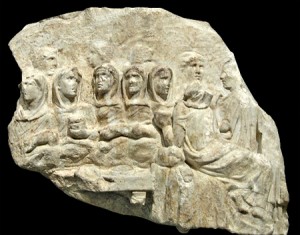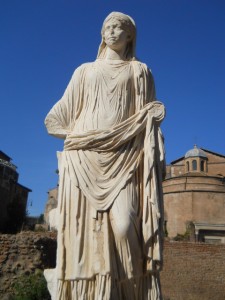This past weekend we celebrated the festival called Caristas, or the Dinner for Dear Ones [Feb. 22]. As the name implies, it is a feast held in celebration of the family. The Caristas feast comes as a culmination of a festival period honoring our deceased family members in the Parentalia [Feb.13-20] and for others who have passed at the Feralia [Feb. 21]. The festival period begins with a solemn memorial held by the Vestal Virgins for the first members of their Order, Gegania and Verania, Canuleia and Tarpeia, all of whom were appointed by Rex Numa Pompilius nearly three-thousand years ago. The Vestals perform a parentatio, which, like other Roman rites and rituals, centers around a specific set of actions, gestures, and prayers. A space is cleaned and ritually swept previously. Pure water, drawn from springs, is sprinkled about during the Praefatio when those who might profane the ceremony are warned away. The Virgo Maxima acts as the main celebrant, ceremoniously washing her hands before offering incense and invoking divine witnesses to attend. The Vestals, led by the head of their Order then move in procession towards and around an altar three times, as they bear offerings for their foremothers. The Virgo Maxima next performs the Invocatio to invite the Goddess Vesta, Gegania, Verania and all those women who have ever served as Vestals for the Goddess. Offerings are made to each in turn – red flowers, incense, wheat, wheat cakes, wine, milk, honey, salt, olive oil and water, and with each offering an adoratio is performed. This is the characteristic gesture of this particular rite parentatio ritual. It consists of a turning motion at the waist, moving from the left side to center when placing offerings into the altar fire, then kissing the back of the right hand, just behind the first knuckle, before touching the right hand to the altar, and then continuing the turning motion of the right hand from forward to the extent to the right. Along with the parentatio sacrifices, the Vestals share a meal with the deceased members of their Order. Over the course of Parentalia, then, all families go out to the tombs of their parents or other family members, holding a sort of picnic with their deceased relatives, during which the parentatio rite is performed with its characteristic adoratio gesture. At the end of the day, before returning home, a final parentatio is performed and candles are lit, which are to remain at the tombs throughout the night to guide the souls back to their celestial homes.

Feralia immediately follows the Parentalia festival. Like the Parentalia, Feralia provides a meal for the dead. However, this meal is not for deceased family members. It is performed outdoors, the head veiled, with the right hand placed on the earth in a protective gesture. Unlike in other Roman rites, in this and other rituals intended for the dead who are not one’s own Lares, the left hand is instead used to place offerings on the altar. The offerings are not burned but are instead left on shards of pottery or on broken crockery. No adoratio is performed. And what is considered an altar here may be no more than a pile of stones near a crossroads or a crude table at the side of a road. Feralia is intended for everyone to pay their annual respect to the dead, especially for those to whom you owe a religious obligation, even when you are unaware that you do. Like the festival of Lemuria in May, we assume that spirits of the dead may roam the earth. This is thought to be particularly true of those who no longer have family who tend to their rites. Thus we leave out some offerings for them at certain times of the year like Feralia.

Parentalia and Feralia concern fulfilling obligations for the dead. Doing so, especially at this time of year, is part of a process of purification. The entire month of February is devoted to purification rites. In fact, the name of the month derives from a Latin term, februa, which is applied to anything used in Roman purification rituals. At the beginning of the month the house is especially cleaned and new wreathes of laurel are placed over the front door. Gathered are the mola salsa, strands of wool, pure water from the surrounding rivers and springs, new utensils and other februa for the coming New Year [March 1]. Roman purification can include abstinence, fasting, bathing, vigils and a variety of acts are to be made, in a complex set of rules depending on which deities are to be invoked. Always included in purification are sacrifices to our ancestors. For whatever else that Roman purification rites entail, most important is reconciling ourselves with our family both in our meal at Caristas and in fulfilling our obligations during Parentalia. While anyone may bathe in water, perform the rite of purification by fire, or the rite of purification by air, it is really only through the pious acts of sacrifice for those who came before us, and through our reverence, focused upon the Gods, that we are purified. The same process of ritual purification is entered into before we must formal Roman ritual. Although these will often include sacrifices to Gods, they should always conclude with sacrifices to the Lares as our ancestors who care for the health and vitality of our family.

The liturgical year draws to a conclusion with the Terminalia on February 23. It is the terminus of the old year and the beginning of the period that looks ahead to the New Year that begins with March. It is dedicated to Terminus, the God of boundaries. Neighbors are to gather at the boundary markers that designate their respective lands, together mending what needs mending and joining together for a common feast. The month began with a festival for Juno Sospita, the Savior Goddess. There were special holidays for Fornax and for Quirinus, and a public purification called Lupercalia in remembrance of Romulus and Remus who first purified Rome. And then we moved through a series of feasts for deceased family members, for the deceased members of our community, then for the living members of our family, and finally with our neighbors. Thus reconciled with all those living around us, we are prepared to enter a New Year, pure and reverent in service to the Gods.
















